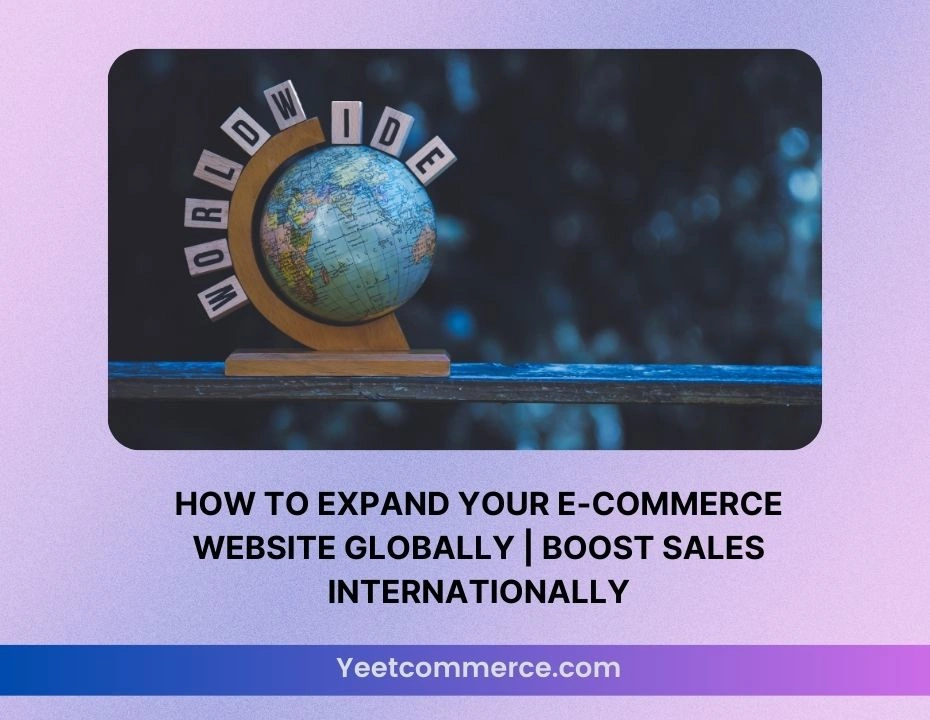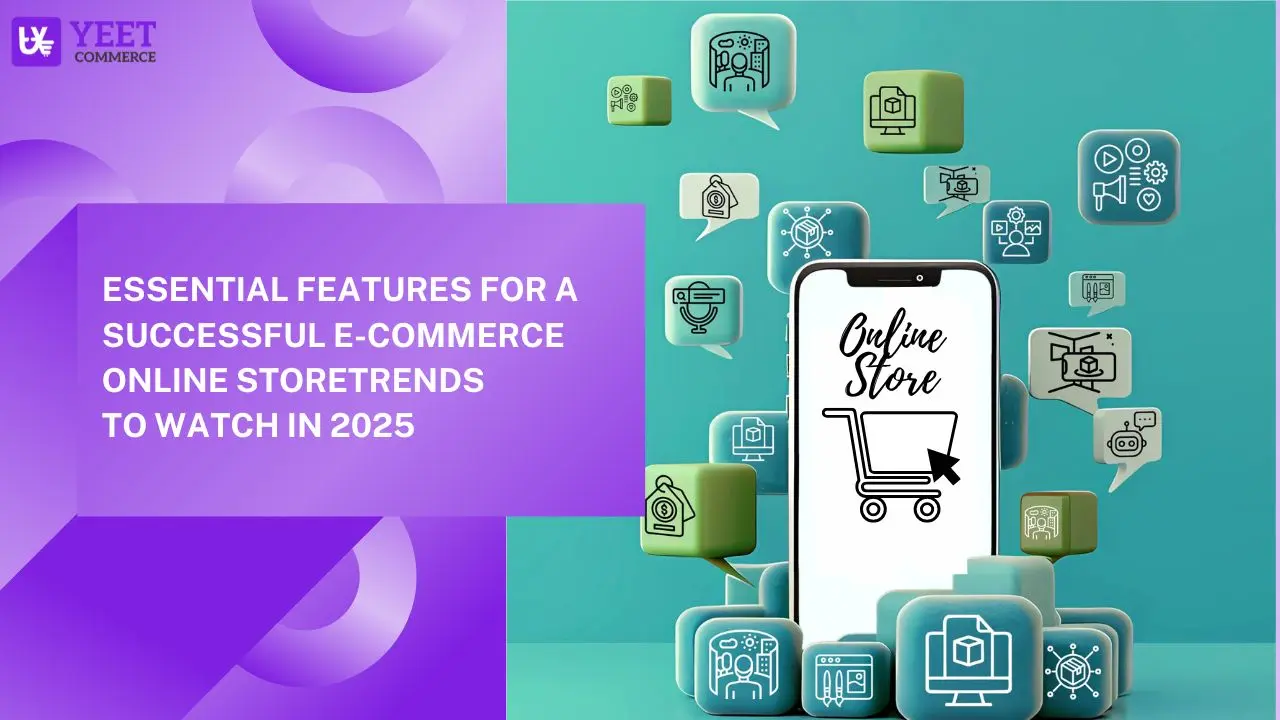In a world shrinking with every click, your business deserves a global stage. An international eCommerce website is your ticket to reaching millions of potential customers across continents. But building a successful online presence that resonates with diverse cultures, languages, and preferences is no easy feat. This blog will be your trusted guide, empowering you with the strategies, insights, and practical tips needed to unlock the full potential of international eCommerce. Let’s embark on this exciting journey together and transform your business into a truly global powerhouse.
Expanding Your Market: How Going Global Can Increase Your Reach
In today’s interconnected world, expanding your market internationally isn’t just a lofty dream—it’s a practical opportunity for growth. If you’re running an eCommerce website, unlocking the potential of international markets can be a game changer. By going global, you’re not just opening new avenues for sales but also tapping into diverse consumer bases. Let’s explore how expanding your market through an international eCommerce website can significantly boost your reach and success.
Embracing Global Opportunities
When you venture into international eCommerce, you’re not merely selling products; you’re entering new cultures and economies. Each market comes with its own unique needs and preferences. For example, a product that’s popular in the U.S. might find an entirely different audience in Asia or Europe. By analyzing these international trends and adapting your offerings, you can cater to a broader audience. It’s like adding extra layers to your business, making it more versatile and resilient. A case study by Gabrielle Olya highlights that “Most Americans now do at least half of their shopping online, with 3 in 5 completing 50% or more of their purchases online and 44% shopping online at least once a week”. This indicates that eCommerce has substantial potential beyond the U.S., as people in other countries also prefer the convenience of online shopping.
One of the biggest advantages of international eCommerce is the sheer volume of potential customers. Imagine having access to markets with millions of potential buyers who are eager for new products. This expanded customer base translates to more opportunities for sales and increased revenue. When you position your website to cater to international customers, you’re not just increasing your reach—you’re significantly enhancing your chances of growth.
Overcoming Local Boundaries
Going global with your eCommerce site breaks down geographical and economic barriers, expanding beyond local market saturation. This shift allows you to tap into untapped international markets, even if your domestic market is crowded. International markets also offer unique opportunities for niche products, turning what’s niche at home into a trend elsewhere. Adaptability and openness to these new possibilities are key to thriving globally.
Enhancing Brand Visibility
Expanding your eCommerce website internationally can significantly boost your brand’s global visibility. Entering new markets not only reaches new customers but also enhances your brand’s reputation, leading to increased recognition and credibility. This broader visibility can foster new partnerships, further elevating your brand. Additionally, international operations often require refining your website’s user experience to cater to diverse audiences, such as optimizing for multiple languages and currencies. These improvements not only benefit international customers but also enhance the overall quality of your site for all users. As noted by Forbes, “Going global helps businesses build brand awareness and customer loyalty, leading to greater opportunities”.
Navigating Challenges with Confidence
While expanding your international eCommerce website presents incredible opportunities, it also comes with its challenges. Expanding your international eCommerce site offers great opportunities but comes with challenges. Here’s how to navigate them effectively:
- Manage Currencies: Use international payment gateways to handle different currencies smoothly.
- Understand Regulations: Stay informed about local regulations to avoid legal issues.
- Handle Shipping: Partner with global logistics providers for efficient international shipping.
- Tailor Marketing: Adapt marketing strategies to fit local cultures and preferences through thorough market research.
By following these steps, you can confidently manage the complexities of international expansion.
Cultural Adaptation: Tailoring Your Site for Diverse Audiences
Navigating the world of international eCommerce can be exciting, but it also requires some cultural finesse. When you’re running an international eCommerce website, understanding and adapting to cultural differences is key to reaching and resonating with diverse audiences. Here’s how tailoring your site for various cultures can make a huge difference.
Understanding Local Preferences
When expanding your eCommerce site internationally, it’s essential to consider local preferences, as cultural differences can greatly influence shopper behavior. For example, color symbolism varies—white may represent purity in Western cultures but mourning in some Asian cultures. Tailoring your website’s design, including color schemes and imagery, to fit local tastes can make a significant impact.
Adapting product descriptions and marketing messages to align with local values is also crucial. A selling point in one region might not resonate in another. As the Harvard Business Review notes, “Localization is more than translation; it’s about making your brand feel local to each customer“.
Localizing Content for Better Engagement
When localizing your international eCommerce site, it’s essential to go beyond simple translation. Localization involves adapting content to fit local languages, idioms, and cultural nuances. Direct translations can often result in confusion or even unintentional offense, as cultural contexts vary widely. For example, a marketing slogan that works well in one language might lose its meaning or relevance when translated directly into another.
To avoid these pitfalls, it’s crucial to work with native speakers or cultural consultants who understand the local market. They can help ensure your content not only makes sense but also feels natural and engaging to the target audience. This can include adjusting phrases, choosing culturally appropriate images, and ensuring that your product descriptions resonate with local values and expectations.
Adapting to Payment and Shipping Preferences
Cultural adaptation also involves practical aspects like payment and shipping. Different regions prefer different payment methods—some may favor credit cards, while others prefer digital wallets or local bank transfers. Offering multiple payment options shows you’re considerate of these preferences, making the shopping experience smoother.
Similarly, providing shipping options that align with local practices and offering clear, accurate delivery times can enhance customer satisfaction. Be mindful of local regulations, such as customs duties and import taxes, and provide clear information about potential extra costs. This transparency can build trust and reduce cart abandonment.
Ensuring an Inclusive User Experience
Creating an inclusive user experience means considering the diverse needs of your global audience. This includes making your site accessible to people with disabilities and ensuring it functions well across different devices and internet speeds. A well-designed international eCommerce website should be easy to navigate and user-friendly, regardless of where your customers are located.
Responsive design is essential for ensuring that your site works seamlessly on various devices, from smartphones to desktops. Additionally, consider incorporating features like language toggles or regional selectors to make it easy for users to navigate and find relevant content based on their location.
Tech Tools for Global Growth: Essential Technologies for International Success
Expanding your eCommerce website to global markets is an exciting endeavor. To navigate this international journey successfully, leveraging the right tech tools is essential. These technologies can streamline operations, enhance user experience, and ensure that your international eCommerce website thrives. Let’s explore some of the key tech tools that can boost your global growth.
Global Payment Gateways: Streamlining Transactions Across Borders
One of the cornerstones of running an international eCommerce website is having a reliable payment gateway. Global payment gateways enable seamless transactions across different countries, supporting multiple currencies and payment methods. This allows customers to complete purchases in their preferred way, enhancing their shopping experience.
For example, a shopper from France can use their local credit card or digital wallet on your site, while you receive the payment in your currency without any hassle. This flexibility is key to accommodating international customers and ensuring smooth, successful transactions.
.
Multi-Language and Localization Tools: Connecting with Global Audiences
To effectively engage international customers, your eCommerce site must speak their language—literally. Multi-language and localization tools are crucial for accurately translating content while respecting cultural nuances. These tools help convert text into various languages and adapt it to fit regional preferences and customs.
Localization involves more than just translation; it includes tailoring content to resonate with local idioms and references. Automated translation services combined with human editing can ensure clear and impactful messaging.
Using Content Management Systems (CMS) with multilingual capabilities simplifies managing and updating content in different languages, enhancing user experience and making your international audience feel valued.
Inventory and Shipping Management Systems: Handling Global Logistics Efficiently
Managing inventory and shipping can be complex when you’re dealing with international markets. To simplify these processes, invest in inventory and shipping management systems designed for global eCommerce. These systems help you keep track of stock levels, manage orders, and coordinate shipping across various regions.
With a robust inventory management system, you can ensure that products are available where they’re needed most. Shipping management tools can help you select the best carriers, calculate shipping costs, and track deliveries. Integration with local logistics providers can streamline shipping processes and improve delivery times, making your international operations more efficient.
Analytics and Reporting Tools: Gaining Insights for Strategic Decisions
Understanding how your international eCommerce website performs in different markets is crucial for making informed decisions. Analytics and reporting tools provide valuable insights into customer behavior, sales trends, and market performance. These tools help you track key metrics such as conversion rates, average order value, and customer acquisition costs.
By analyzing this data, you can identify which regions are performing well and which might need more attention. Insights into customer preferences and buying patterns can guide your marketing strategies and product offerings. Advanced analytics tools can also help you monitor competitor performance and stay ahead in the global marketplace.
Customer Relationship Management (CRM) Systems: Enhancing Global Customer Engagement
Maintaining strong relationships with your international customers requires effective communication and personalized service. CRM systems designed for global eCommerce can help you manage customer interactions and provide tailored support. These systems allow you to segment your customer base, track interactions, and automate follow-ups.
With a CRM system, you can send personalized emails, offer targeted promotions, and address customer inquiries promptly. This level of engagement helps build trust and loyalty among your international audience. Look for CRM solutions that integrate seamlessly with your eCommerce platform and offer features like multi-language support and regional segmentation.
Financial Benefits and Expenses of International eCommerce
Expanding your eCommerce website internationally brings significant financial benefits and considerations. On the upside, reaching a global audience can substantially increase your revenue potential by tapping into diverse markets with varying purchasing power. For instance, a report by McKinsey & Company highlights that global eCommerce sales are projected to reach $6.3 trillion by 2024 , emphasizing the vast opportunities for growth beyond domestic borders (McKinsey & Company, 2023). However, the financial landscape isn’t without its challenges. Expenses can escalate due to increased shipping costs, international transaction fees, and localized marketing efforts. Additionally, adapting your website for different languages and currencies, along with compliance with various regulatory standards, can be substantial. According to a study by Deloitte, international expansion costs can range from 10% to 30% of the total budget depending on the market (Deloitte, 2023). Yet, these investments can yield impressive returns if managed wisely. By improving conversion rates through tailored marketing strategies and localized content, you can offset these costs and boost your international eCommerce success. Effective optimization and strategic planning will ensure that your global expansion remains both profitable and sustainable.
Case Studies: Brands That Thrived with International eCommerce
In the fast-paced world of eCommerce, expanding your reach to global markets can be the key to unprecedented growth. Some brands have not only embraced this challenge but have thrived, setting the standard for success in international eCommerce. Let’s explore how three notable brands—YeetCommerce, Amazon, and Walmart—have leveraged their platforms to become global powerhouses. Their strategies offer valuable insights for anyone looking to take their international eCommerce website to the next level.
1. YeetCommerce: Powering Global Entrepreneurs
YeetCommerce, a rising star in the eCommerce platform arena, has quickly gained a reputation for empowering small to medium-sized businesses to go global. What sets YeetCommerce apart is its focus on user-friendly tools that make international expansion accessible, even for those new to the eCommerce game.
One of YeetCommerce’s standout features is its built-in multi-language support, which allows you to easily create localized versions of your website. This feature is crucial when entering new markets, as it helps you communicate with customers in their native languages, making them feel more comfortable and connected to your brand. YeetCommerce also supports multiple currencies and payment gateways, ensuring that your customers can make purchases using their preferred methods.
But the magic doesn’t stop there. YeetCommerce’s analytics tools provide invaluable insights into customer behavior across different regions. You can track what products are popular in specific countries, which helps you tailor your inventory and marketing strategies accordingly. By understanding and responding to the needs of your global audience, you’re not just selling products—you’re building relationships that transcend borders. YeetCommerce’s success stories, like that of ChicThreads and GadgetHub, demonstrate that with the right platform, even a small brand can thrive on an international scale.
2. Amazon: The Epitome of Global eCommerce
No discussion of international eCommerce would be complete without mentioning Amazon, the giant that redefined how the world shops. Amazon’s global success is a testament to the power of a well-executed international strategy. From its humble beginnings as an online bookstore, Amazon has expanded into virtually every market, offering everything from electronics to groceries, and reaching customers in over 200 countries.
Amazon’s international eCommerce success can be attributed to several key strategies. First, their relentless focus on customer satisfaction has been pivotal. Amazon’s Prime service, which offers fast shipping and exclusive deals, is available in multiple countries, creating a loyal customer base that spans the globe. Additionally, Amazon has invested heavily in localization, ensuring that each country’s site is tailored to meet local preferences, from product recommendations to payment methods.
Another factor in Amazon’s international success is its robust logistics network. Amazon has built a global distribution system that allows them to fulfill orders quickly and efficiently, no matter where the customer is located. Their use of advanced technology, such as AI and machine learning, to predict customer demand and manage inventory, has further strengthened their global operations. For anyone looking to expand their international eCommerce website, Amazon’s model is a masterclass in combining technology, logistics, and customer focus to dominate the global market.
3. Walmart: A Retail Giant Goes Global
Walmart, the world’s largest retailer, has also made significant strides in the international eCommerce arena. Known for its massive brick-and-mortar presence, Walmart recognized the growing importance of online shopping and made a concerted effort to expand its eCommerce capabilities, particularly in global markets.
Walmart’s international eCommerce strategy has been marked by strategic acquisitions and partnerships. For instance, their acquisition of Flipkart, a leading eCommerce site in India, allowed Walmart to gain a strong foothold in one of the world’s fastest-growing markets. By leveraging Flipkart’s existing infrastructure and local expertise, Walmart was able to quickly scale its operations in India, offering a wide range of products to millions of customers.
In addition to acquisitions, Walmart has focused on enhancing its international eCommerce website by integrating advanced technology. They’ve invested in AI-driven personalization tools that recommend products based on customer behavior and preferences. Walmart has also streamlined its supply chain to ensure that products are delivered efficiently, regardless of the customer’s location. Their commitment to innovation and local adaptation has enabled Walmart to compete effectively in the global eCommerce landscape, proving that even a traditional retail giant can successfully transition to the digital world.
Conclusion
Expanding your eCommerce website internationally opens new growth opportunities and positions your brand on a global stage. Tailoring your site to diverse audiences through cultural adaptation, localization, and inclusive design is essential. Leveraging global payment systems, multi-language tools, and advanced tech can streamline operations and enhance customer experiences. By learning from successful brands and applying strategic approaches, you can thrive in the global market and watch your international eCommerce efforts flourish.


















